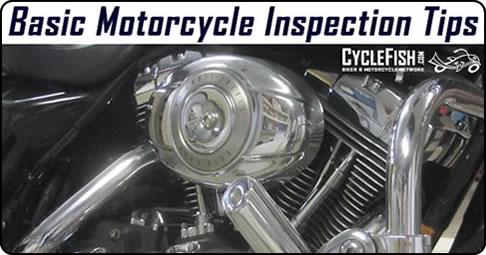Whether your motorcycle has been for a bit, or you have been regularly riding, it is important to perform periodic inspections of your bike. It's also important to thoroughly inspect a used or pre-owned motorcycle you've just purchased. By doing so, you will ensure both safety and reliability, preventing you from spending your day stranded on the curb instead of riding on the open road.

Every motorcycle will vary slightly in how to inspect certain parts. You should have a service or maintenance manual handy to know the specifications for your motorcycle.
Here are some general tips to check out the basic systems of most motorcycles:
Electrical Inspection Check:
- Head light high/low beam
- Tail/brake light
- Turn signals & horn
- Instrument & driving lights.
- Test Kill button/switch
- Inspect overall wiring for chafe. Use wire ties to secure loose wires. A quick shot of silicon spray will keep switches & locks healthy.
- Check battery levels and clean terminals. Baking soda & water will clean corrosion from the post (Don't get it inside the battery), a bit of petroleum jelly or grease will help prevent future corrosion.
- Check the ground (-) cable at both ends to ensure it is clean and tight.
- Inspect starter connections & mounting bolts. Check shaft for excessive wear if noisy.
- Check fuse box for loose or damaged fuses. Carry spare fuses.
Engine Fluids Check:
- Levels of all fluids
- Condition of all fluids. If engine/transmission oil is very dark or smells burnt, change oil & filter.
- Fuel filter & screens for crud and check lines for chafe and dry rot.
- Water cooled Engines: Check coolant/anti-freeze level, as well as the flow/pump/hoses.
Brake Check:
- Adjust lever & pedal travel. Refer to your owners/shop manual for specs.
- Master cylinders for clean brake fluid & proper fluid levels.
- Brake lines for wear, cracking & leaks. Any brake fluid on the lines or around any of the connections means the brake system is leaking and REQUIRES attention.
- Irregular or "jerky" stopping may mean a warped rotor or drum.
- Inspect pads/liners and replace if needed. Don't let a front brake grab on wet pavement.
Brakes are possibly the most important component on a bike. If you are not sure on how to correctly inspect the brakes & brake system, take your bike to an authorized service center!
Tire & Wheel Check:
- Inspect tires for even wear, tread depth and dry rot (cracking) or cuts in side walls.
- Inspect valve stems for dry rot (and rim cuts on tube stems).
- Air pressure. Do not over inflate especially in Hot conditions/climate.
- Inspect rims for dents, cracks (alloy) and Carefully tighten loose spokes.
- Check axles, axle nuts & hardware for tightness & wear and lube the bearings.
- Inspect drive chain(& lube) or belt for excessive wear and adjust/replace as needed.
Engine & Transmission Check:
- Check spark plugs. Brown to grayish-tan is good. Black is probably from burning oil or a rich fuel/air mix., light gray or whitish can mean a lean fuel/air mix or an intake leak. You can go here to learn more about Spark Plug Inspection & Diagnosis
- Check carb(s), adjust float level(s) & idle/fuel/air. Clean carbs are happy carbs... Aerosol Carb/Injector cleaner can work wonders on carburetor or fuel injected motors.
- Inspect/adjust ignition components & replace old spark plugs & wires.
- About every 1,000 miles, check nuts, bolts & screws for tightness.
- nspect oil lines for leaks, cracks or chafe & look for oil leaks from the engine/trans. case(s).
- Inspect air filter(s) and if dirty, replace or clean depending on type.
- Inspect exhaust for leaks (especially at the manifold) and check mounting brackets.
- Adjust clutch, replace plates if slipping or dragging. Check primary drive chain/belt.
Frame & Suspension Check:
- Check/tighten/torque all nuts & bolts, & engine/trans. mounting hardware.
- Hair line cracks around engine/transmission mounting brackets.
- Check steering head/fork assembly for looseness/tightness and adjust if needed.
- Lube steering(tree) bearings.
- Check fork fluid level (refer to owners manual, use only approved hydraulic fluid).
- Inspect rear shock(s), (replace if worn or soft) and check fender mounting brackets/hardware.
- Inspect handle bars for cracks, check mounts and oil all cables.
If you are not familiar or comfortable with working on your own motorcycle, we recommend that you bring it in to a trained motorcycle mechanic at least once a year for a good overall inspection.
Looking for Motorcycle Events?
Check the CycleFish Event Calendar!
1000s of Local, Regional & National Events Listed!
October 4, 2017- -
-
Report